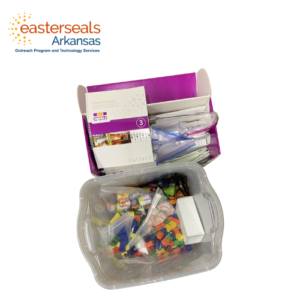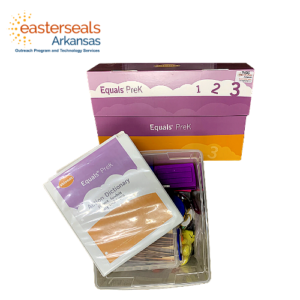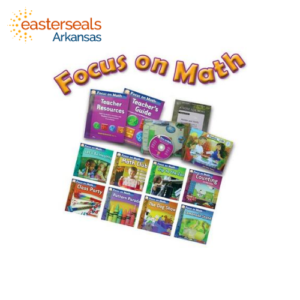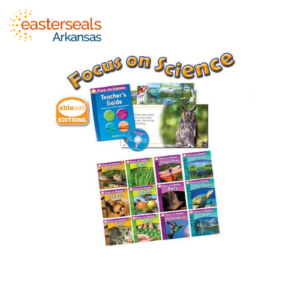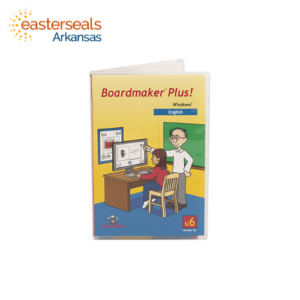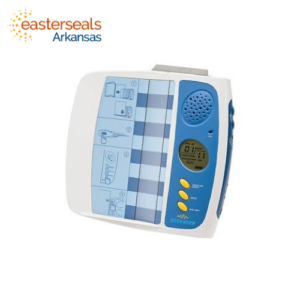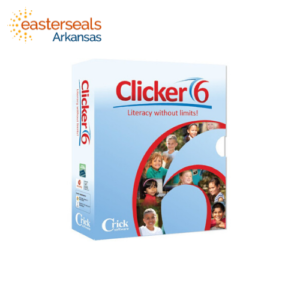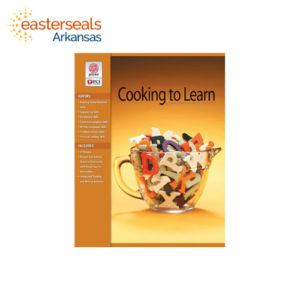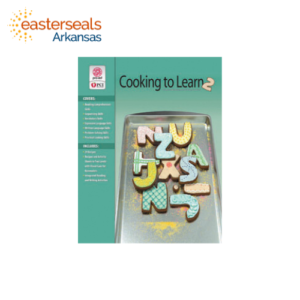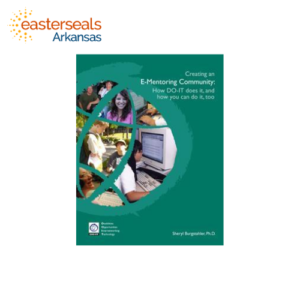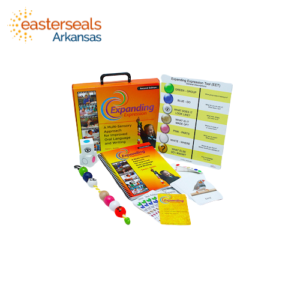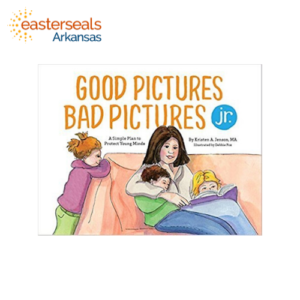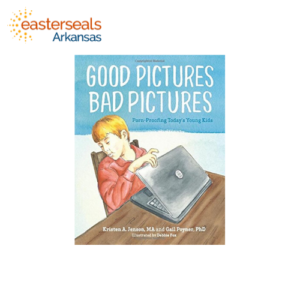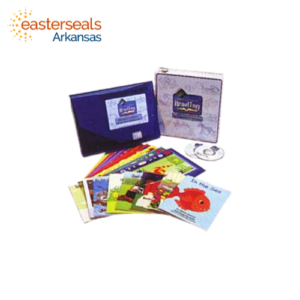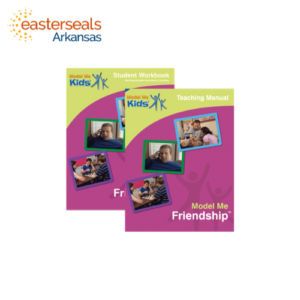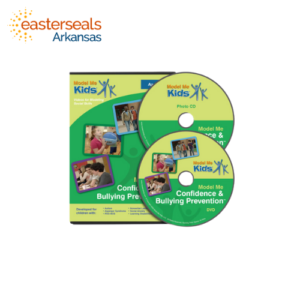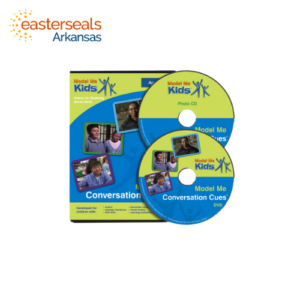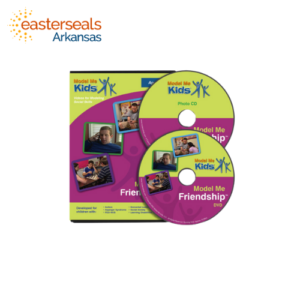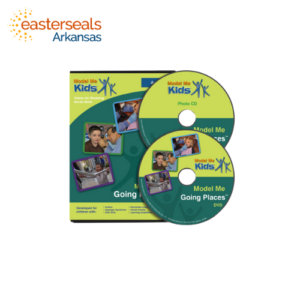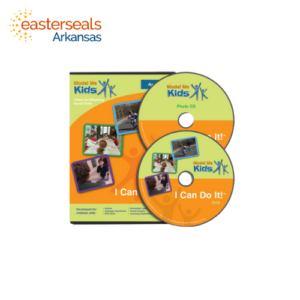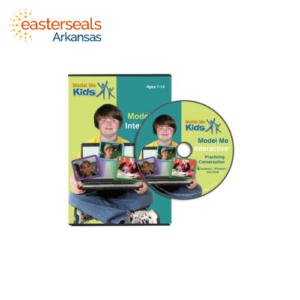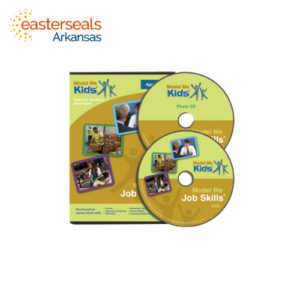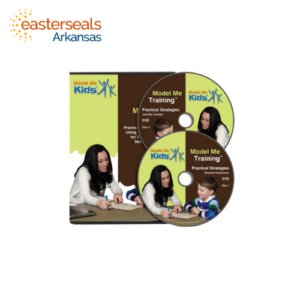-
The Equals Pre-K Math curriculum is designed for students with disabilities currently in a preschool setting with special education services. With Equals Pre-K Math, students, including students with significant and intellectual disabilities, learn readiness math as active learners. Equals Pre-K features thoughtfully ordered and connected lesson objectives, learned skills and vocabulary connected to future lessons, and assessment administered in play-based/center-based format. The curriculum is aligned to state preschool standards and guidelines.This Product Includes:
-
Math curriculum. ***This product has been discontinued by the manufacturer.
-
Science curriculum ***This product has been discontinued by the manufacturer.
-
Boardmaker® Plus! offers all the same features as Boardmaker® for creating print-based materials, and it doesn't stop there. Boardmaker® Plus! transforms your paper activities – and your students' learning experience – by making your activities interactive for use on the computer with sound, animation and video. With Boardmaker® Plus!, you can create all of the same materials you do with Boardmaker® - practice quizzes, worksheets, schedules, books, writing activities, games and more in 44 languages. And, with Boardmaker® Plus!, you can make them talk, prompt and support your students as they learn. ***The manufacturer sells an updated version of this product.
-
The BookWorm’s eight-minute memory module offers you the flexibility to record as many as 32 pages – enough time for adapting two text-rich books or up to four short books. Adapting a book is easy. Simply attach a removable sticker to each page of your student’s favourite book and record the story, page-by-page into the BookWorm. The stickers serve as a guide indicating where to push for playback. ***This item has been discontinued by the manufacturer.
-
Felt and plastic choice boards that can be used with PECS pictures, vocabulary cards, visual choices, etc.
-
Wrightslaw: From Emotions to Advocacy, second edition will teach you how to plan, prepare, organize and get quality special education services. In this comprehensive, easy-to-read book, you will learn about your child's disability and educational needs, how to create a simple method for organizing your child's file and devising a master plan for your child's special education.You will understand parent-school conflict, how to create paper trails and effective letter writing. This book includes dozens of worksheets, forms and sample letters that you can tailor to your needs. Whether you are new to special education or an experienced advocate this book will provide a clear roadmap to effective advocacy for your child. You will use this book again and again.
-
Clicker 5 is a child-friendly writing tool which helps students of all abilities to develop literacy skills. ***The manufacturer sells an updated version of this product.
-
Clicker 6 is a child-friendly writing tool which helps students of all abilities to develop literacy skills. ***The manufacturer sells an updated version of this product.
-
The Cooking to Learn Series is integrated reading and writing activities that motivate students to learn basic reading and writing skills with the fun step-by-step cooking activities and corresponding worksheets in these three books. The easy-to-follow recipes offer life-skills experience as students prepare food themselves using common inexpensive ingredients. Each recipe features illustrated and non-illustrated activities to allow teachers to use the same lesson plan with students of varying abilities. Recipes in each book include a selection of breakfast, lunch or dinner, snack and dessert, and drink choices.
-
The Cooking to Learn Series is integrated reading and writing activities that motivate students to learn basic reading and writing skills with the fun step-by-step cooking activities and corresponding worksheets in these three books. The easy-to-follow recipes offer life-skills experience as students prepare food themselves using common inexpensive ingredients. Each recipe features illustrated and non-illustrated activities to allow teachers to use the same lesson plan with students of varying abilities. Recipes in each book include a selection of breakfast, lunch or dinner, snack and dessert, and drink choices.
-
Do you want to begin or enhance a program to help young people successfully transition to college and careers? Do you want to reduce preparation time by starting with materials and forms that have been created by a successful program? This book was written for you! It can help you create summer study, work-based learning, and e-mentoring programs for youth. Key considerations are highlighted to help you get started in developing programs that include computer technology access, peer and mentor support, college preparation activities, and work-based learning. Organizational details shared in this book have been implemented for more than fourteen years at the University of Washington in Seattle. Applying these practices can promote the development of self-determination and technology skills that contribute to success in college, careers, and independent living. Chapter One provides an overview of research that supports DO-IT practices. The chapters that follow share how DO-IT employs evidence-based practices in a cohesive set of programs and activities for students who have disabilities. Within those chapters you will see how
-
This book explores positive internal characteristics and external factors that contribute to success--personally, socially, spiritually, academically, and professionally. These factors can be used to provoke thought and promote interaction between teens and caring adults. In this book you will not find the stories of movie stars, international leaders, or other celebrities. Although the content is based on personal experiences of successful people with disabilities, all of the people represented here would not be considered super-achievers in all areas of their lives. You'll hear the stories of everyday people striving for the best life has to offer. This book highlights advice from people who confront barriers as challenges rather than deterrents and who find insight and humor during trying times. It shares some of the attitudes, skills, and strategies that have contributed to the success of people with a wide range of disabilities, abilities, experiences, and personalities. The experts who provide the major content for this book share their dreams, goals, challenges, successes, and frustrations. They tell about their experiences and give advice about how to successfully transition from high school to college, careers, and independent living. Perhaps their stories will provide inspiration as you help those around you define and achieve success for themselves.
-
We use a simple mulitsensory approach that guarantees quick results. This tool can be used for general descriptions, writing from prior knowledge, autobiographies/biographies, summarizing and more. The Expanding Expression Tool (EET) helps to build the following language skills: Oral expression, Written expression, Vocabulary comprehension, Defining and describing, Making associations, Stating functions of objects, Categorization, Similarities and differences, Students quickly learn each symbol and consistently describe and define objects and items providing 6-7 details in an organized manner. Entire schools have adopted the program to facilitate improved expression and comprehension. It is being used with students in preschool through high school in both general and special education classrooms. It allows students to quickly progress from word to phrase to paragraph to multi-paragraph levels.
-
Young children deserve to be armed early against internet dangers. Good Pictures Bad Pictures Jr.makes it easy for parents to protect their young kids ages 3 to 6. Using gentle, age-appropriate messages, children will learn to Turn, Run & Tell when they are accidentally exposed to inappropriate content.
-
Good Pictures Bad Pictures is a comfortable, read-aloud story about a mom and dad who teach their child what pornography is, why it's dangerous, and how to reject it. Using easy-to-understand science and simple analogies, this ground-breaking book engages young kids to porn-prooftheir own brains.
-
Designed by experts in literacy and special education, Balanced Literacy provides a sequential, balanced approach to give students the multisensory reinforcement they need to become successful readers through: guided reading, supported writing, word study, phonics activities, multi-sensory reinforcement, and extensive practice. ***This item has been discontinued by the manufacturer.
-
Kaufman Kit 1 teaches children to combine consonants and vowels to form words while controlling for oral-motor difficulty. The 225 visual referent cards were selected specifically to target and teach the syllable shapes that are the building blocks of speech for children to master in order to become effective vocal/verbal communicators. Treatment methods employ a systematic and progressive approach of simplifying word pronunciation patterns to shape and expand verbal expression and make communication easier for children with childhood apraxia of speech and other speech sound disorders. ***The manufacturer sells an updated version of this product.
-
Kit 1: Teach children to combine consonants and vowels to form words while controlling for speech motor coordination difficulty. Includes the syllable shapes children need to master to become effective vocal/verbal communicators. Includes 225 durable and engaging picture cards (5"x7"). Synthesis of /b, d, h, m, n, p, t, w/. Teaches unique pivot syllables such as "ny" or "dle" which are not included in other apraxia materials. Kit 2: Once a child has mastered the sounds in Kit 1, use Kit 2 to refine articulation and build intelligibility. Features familiar two and three-syllable words to target more complicated speech motor skills and synthesis into initial and final word positions. Includes 285 durable and engaging picture cards (5"x7"). Synthesis of /f, g, k, l, s, sh/ and blends /s, r, l/. Features the pivot syllables: low, ber, ter and ing. Kaufman Workout Book, 1st Ed.: Teach children to combine words to formulate expressive language. Outlines 16 specific speech motor coordination workouts. Each workout explains the targeted skill, describes how to perform the exercise, and specifies help to be offered to the child. Includes scripting and cueing techniques plus targets word retrieval and grammatical development. Colorful, engaging artwork featuring the Mutt Family characters. Hardcover, 133 pages (12" x 9"). DVD Set includes three DVDs with instruction protocol for Kaufman Speech to Language Protocol.
-
This boxed curriculum contains teacher guides, student workbooks, cards, music, and supplemental materials for teaching handwriting to students from pre-k to 4th grade.
-
Model Me Kids Teaching Manuals are a complement to its video modeling videos and help extend the lessons taught in the videos. These resources help teach social skills at home, in a classroom, social skills group, or other teaching setting
-
The Model Me Airplane™ video presents the essential elements of air travel. Follow Owen as he goes through the airport, security, and boarding. Then join him on the plane as he listens to the flight attendant, buckles his seatbelt, and enjoys the plane ride.Recommended for ages 3-14
-
Model Me Confidence & Bullying Prevention™ provides children with Autism a teaching tool for preventing bullying and building self-esteem. The video is hosted by children from the video, who narrate each scene. The visual is combined with narration and graphics that help explain the particular rule. Each skill is demonstrated in more than one situation and across environments. This is useful to children with Autism because it helps with generalization of the skill taught. Recommended for Ages 9-17.
-
Copy 1 of 2 The Model Me Conversation Cues™ video features middle and high school-aged children demonstrating social skills at school and in the community. Each scene lasts between 30 seconds and 3 minutes, depending on the chapter. At the end of each chapter is a storyboard summarizing the rules taught. Hosted by teenagers from the video who narrate each scene. The visual is combined with narration and graphics that help explain the particular rule. Each conversation skill is demonstrated in more than one situation and across environments. This is useful to children with Autism because it helps with generalization of the skill taught. Recommended for ages 9-17
-
Copy 2 of 2 The Model Me Conversation Cues™ video features middle and high school-aged children demonstrating social skills at school and in the community. Each scene lasts between 30 seconds and 3 minutes, depending on the chapter. At the end of each chapter is a storyboard summarizing the rules taught. Hosted by teenagers from the video who narrate each scene. The visual is combined with narration and graphics that help explain the particular rule. Each conversation skill is demonstrated in more than one situation and across environments. This is useful to children with Autism because it helps with generalization of the skill taught. Recommended for ages 9-17
-
The Model Me Faces & Emotions™ video presents a variety of faces and emotions featuring children ages 2-8. Each scene lasts between 1-2 minutes, depending on the chapter. At the end of each chapter is a storyboard summarizing the emotion shown. Each emotion is demonstrated in more than one situation and across environments. This is useful to children with Autism because it helps promote generalization. Recommended for ages 2-8
-
The Model Me Friendship™ video presents social skills needed to develop and maintain friendship. It features teen-aged children demonstrating appropriate social skills at school, playing on sports teams, eating at a restaurant, and in other settings. Each scene lasts between 30 seconds and 3 minutes, depending on the chapter. At the end of each chapter is a storyboard summarizing the rules taught. The video is hosted by the children in the video, who narrate each scene. The visual is combined with narration and graphics that help explain the particular rule. Each social skill is demonstrated in more than one situation and across environments. This is useful to children with Autism because it helps with generalization of the skill taught.Recommended for ages 9-17
-
The Model Me Going Places™ video features children, ages 2-8, involved in activities in the community. It is designed to familiarize children with locations that may be challenging, and to help teach appropriate behavior in these locations through peer modeling. Each scene lasts between 2-4 minutes, depending on the chapter. At the end of each chapter is a storyboard summarizing the locations shown. Recommended for ages 2-8
-
The The I Can Do It!™ video presents social skills in the context of challenging circumstances. It features elementary school-aged children demonstrating appropriate behavior in a variety of difficult situations. Each scene lasts between 30 seconds and 3 minutes, depending on the chapter. At the end of each chapter is a storyboard summarizing the rules taught.The video is hosted by the young children in the video, who narrate each scene. The visual is combined with narration and graphics that help explain the particular rule. Each social skill is demonstrated in more than one situation and across environments. This is useful to children with Autism because it helps with generalization of the skill taught. Recommended for ages 5-12
-
Model Me Interactive™: Practicing Conversation For Ages 7-13 | Developed for children with Autism, Asperger Syndrome, and Developmental Delays. For a laptop with webcam. Model Me Interactive™: Practicing Conversation combines video modeling teaching tools with the interactive capability of software. First, video models a conversation between children. Then, the student practices the conversation using a webcam. The practice conversation is recorded and a feedback area allows teachers to comment on and grade a student's recordings. Ideal for professionals including teachers, therapists, and speech language pathologists.
-
The Model Me Job Skills™ video models social skills helpful for gaining and maintaining employment. The video is hosted by the young adults in the video, who narrate each scene. The visual is combined with narration and graphics that help explain the particular rule. Each social skill is demonstrated in more than one situation and across environments. This is useful to individuals with Autism because it helps with generalization of the skill taught. Recommended for ages 15-21
-
This DVD examines video modeling as an evidence-based method of improving social skills in children with autism spectrum disorder (ASD). Children with ASD often have social skills deficits that interfere with success. Video modeling has been found to be an efficient and effective method of teaching social skills to children with ASD. We address how to implement a video modeling program, pairing video modeling with other social skills training approaches, and strategies for generalization of skills.
-
Model Me Movement™: Balance, Core, & Calming is a video of short, easy-to-follow movement activities developed by Occupational Therapist Dr. Fabiane Curro. The video is designed to improve balance, increase core strength, and promote self-calming. The DVD contains six 8-11 minute movement segments each modeled by a child and guided by an adult. The activities are designed to target skills that help with coordination, body awareness, self-regulation, and promote an overall feeling of physical well-being.Recommended for ages 9-17
-
The Model Me Organization & Motivation™ video presents skills related to organization and self-motivation. It features teen-aged children demonstrating how to get organized and stay motivated. Each scene lasts between 30 seconds and 3 minutes, depending on the chapter. At the end of each chapter is a storyboard summarizing the rules taught.The video is hosted by the children in the video, who narrate each scene. The visual is combined with narration and graphics that help explain the particular rule. Each skill is demonstrated in more than one situation and across environments. This is useful to children with Autism because it helps with generalization of the skill taught. Graphics and music are used to make the video appealing to children with Autism.Recommended for ages 9-17

